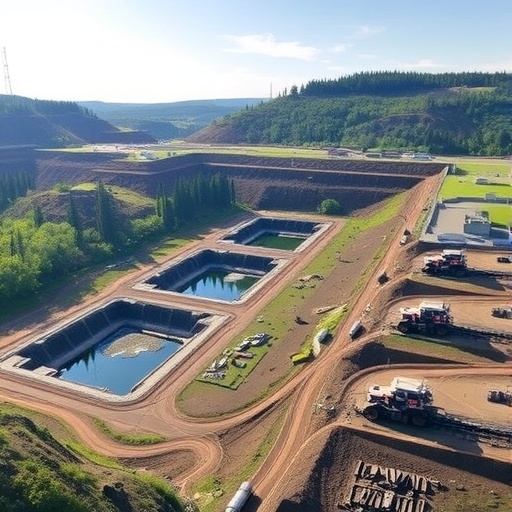In recent years, the evolution of our approach toward land management following extraction processes such as mining has gained significant traction. Within this context, the concept of mine reclamation stands at the forefront, reflecting a shift from purely extracting resources to considering a more holistic management that maintains ecological balance and supports sustainable practices. This has proven particularly pertinent in regions like Pali, Rajasthan, where the unique geological formations, specifically the Barr Conglomerate, form both a geological asset and a potential hub for geo-heritage tourism.
In his recent publication, A. Nag explores these dimensions in depth, focusing on stakeholder perceptions of mine reclamation juxtaposed with the burgeoning field of geo-heritage tourism. Drawing from both empirical data and theoretical frameworks, Nag sheds light on how local communities, businesses, and ecological groups respond to such initiatives. The research reveals a complex interplay of interests that shapes sustainable development trajectories within mining regions.
Historically, mining activities have often led to environmental degradation, dismissing local ecological contexts in favor of short-term economic gains. However, as communities become increasingly aware of the environmental challenges posed by traditional mining practices, there has emerged a collective desire to leverage the aftermath of mining for greater ecological and socio-economic benefit. Herein lies the crux of Nag’s research—mining reclamation is being reimagined as not just a method of environmental restoration, but as a viable avenue toward enhancing local tourism and economic resilience.
The Barr Conglomerate is particularly significant because of its unique geological characteristics. Composed of a diverse assortment of sedimentary rocks, it serves as a striking illustration of Earth’s geological history. These features are not only valuable for scientific research but also possess an intrinsic allure that can attract eco-tourists and geologists alike. By promoting sustainable tourism practices, stakeholders can transform a former mining site into an economic asset that also appeals to nature enthusiasts and history buffs.
Nag’s research methodically assesses stakeholder perceptions, revealing that local communities often harbor a wealth of traditional ecological knowledge that could underpin sustainable reclamation practices. Engaging these communities in conversations around reclamation can lead to innovative solutions that are both environmentally sound and culturally sensitive. This underscores the importance of participatory frameworks that empower local voices in the decision-making process—a theme that resonates strongly across the current discourse in sustainable development.
Transitioning from a focus solely on extraction to integrating tourism and environmental stewardship requires a paradigm shift among stakeholders. Many local business owners express enthusiasm regarding the potential economic benefits of geo-heritage tourism, citing prospects for job creation and increased revenue through visitors intrigued by the unique geological aspects of the Barr Conglomerate. However, these sentiments are often tempered by concerns regarding the ecological implications of increased foot traffic and infrastructure development that tourism demands.
This duality of perceptions is a central theme in Nag’s study. By capturing this nuance, the research acts as a springboard for dialogue among stakeholders. The paper posits that successful reclamation initiatives will hinge on carefully balancing ecological integrity with economic aspiration—a challenge that necessitates the collaboration of diverse interests including government, industry, and civil society.
To facilitate this balance, effective policy frameworks must emerge that not only provide guidelines for reclamation but also incentivize sustainable practices across the tourism sector. These could involve tax breaks for businesses adhering to eco-friendly practices or grants for initiatives aimed at preserving local geology. By embedding sustainability into the legislative fabric, stakeholders gain reassurance that their economic pursuits will not undermine ecological health.
Furthermore, Nag emphasizes the role of education in fostering an environmentally conscious ethos among stakeholders. Local schools and community centers could become venues for programs aimed at teaching residents about geology, ecology, and sustainable practices. This educational outreach not only cultivates a knowledgeable populace but also reinforces the intrinsic value of the natural landscape, instilling pride in local heritage.
The implications of Nag’s findings extend beyond Pali and the Barr Conglomerate; they resonate within broader frameworks of sustainable development worldwide. As communities grapple with the legacies of resource extraction, the insights gleaned here can serve as a model for other regions facing similar challenges. The shift towards geo-heritage tourism, as underscored in this research, reflects an emerging global recognition of the importance of harmonizing economic and ecological interests.
In conclusion, Nag’s study represents a critical step in understanding the dynamics of mine reclamation and stakeholder perceptions in a specific geographical context. By integrating community voices, fostering educational initiatives, and aligning policies with sustainable development goals, regions previously marred by mining activities can embark on a new path toward resilience and ecological stewardship. As this narrative of reclamation evolves, it highlights the vital connections between local heritage, community engagement, and sustainable practices in the face of a rapidly changing global landscape.
As we ponder the future of such territories, it becomes increasingly clear that recognizing the multifaceted nature of sustainability is imperative. It prompts each stakeholder to reflect not just on their immediate economic interests but also on the long-term implications of their actions on the environment and their communities. With thoughtful collaboration and an unwavering commitment to ecological values, a transformed landscape awaits—a landscape that thrives on the intersection of heritage, nature, and sustainable tourism.
Subject of Research: The shift from mine reclamation to geo-heritage tourism and stakeholder perceptions in Pali, Rajasthan, India.
Article Title: From mine reclamation to geo-heritage tourism: assessing stakeholder perceptions and sustainable practices at barr conglomerate, Pali, Rajasthan, India.
Article References:
Nag, A. From mine reclamation to geo-heritage tourism: assessing stakeholder perceptions and sustainable practices at barr conglomerate, Pali, Rajasthan, India. Discov Sustain 6, 1041 (2025). https://doi.org/10.1007/s43621-025-01909-z
Image Credits: AI Generated
DOI: 10.1007/s43621-025-01909-z
Keywords: Mine reclamation, geo-heritage tourism, stakeholder perceptions, sustainable practices, Barr Conglomerate, Pali Rajasthan.




